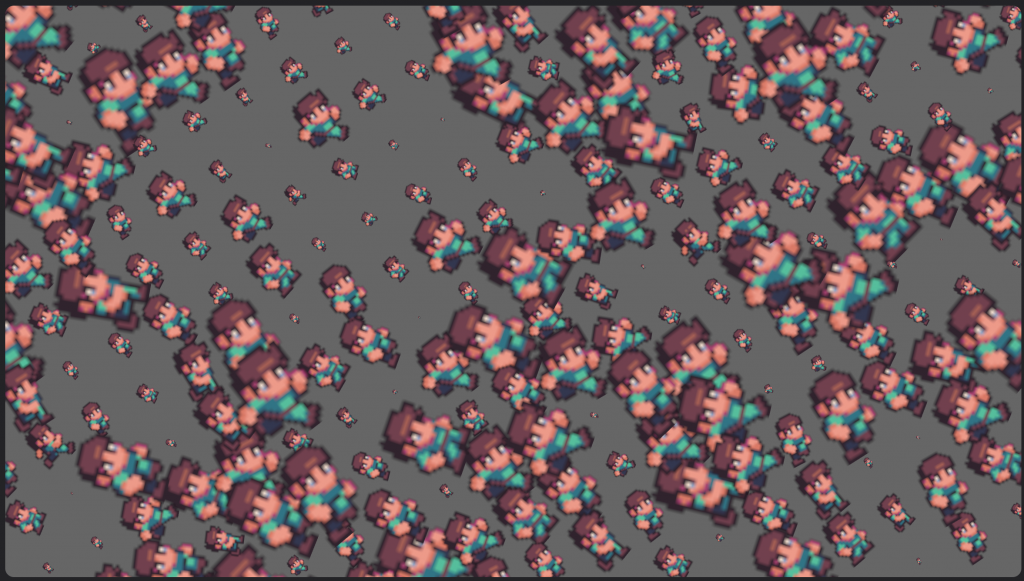今天主要分享的是如何在Bevy中進行壓力測試。壓力測試是為了檢查遊戲或應用程式在極端情況下的表現。以下是一段用Bevy實現的壓力測試程式,我們將使用大量的角色來模擬極端情況。
在此程式中,我們首先初始化一些基本設置,如瓷磚大小、地圖大小等。接著,使用隨機數生成器來給每個角色賦予隨機的位置、旋轉和大小。這將產生大量的角色,模擬遊戲或應用程式在極端情況下的情景。
此外,還定義了幾個系統,如移動攝像機、角色動畫以及定期顯示角色數量的系統,以便我們可以看到遊戲的實際表現。
//! Renders a lot of animated sprites to allow performance testing.
//!
//! This example sets up many animated sprites in different sizes, rotations, and scales in the world.
//! It also moves the camera over them to see how well frustum culling works.
use std::time::Duration;
use bevy::{
diagnostic::{FrameTimeDiagnosticsPlugin, LogDiagnosticsPlugin},
math::Quat,
prelude::*,
render::camera::Camera,
window::PresentMode,
};
use rand::Rng;
const CAMERA_SPEED: f32 = 1000.0;
fn main() {
App::new()
// Since this is also used as a benchmark, we want it to display performance data.
.add_plugins((
LogDiagnosticsPlugin::default(),
FrameTimeDiagnosticsPlugin,
DefaultPlugins.set(WindowPlugin {
primary_window: Some(Window {
present_mode: PresentMode::AutoNoVsync,
..default()
}),
..default()
}),
))
.add_systems(Startup, setup)
.add_systems(
Update,
(
animate_sprite,
print_sprite_count,
move_camera.after(print_sprite_count),
),
)
.run();
}
fn setup(
mut commands: Commands,
assets: Res<AssetServer>,
mut texture_atlases: ResMut<Assets<TextureAtlas>>,
) {
// 從外部文件中載入警告訊息
warn!(include_str!("warning_string.txt"));
// 初始化隨機數生成器
let mut rng = rand::thread_rng();
// 設定瓷磚大小和地圖大小
let tile_size = Vec2::splat(64.0);
let map_size = Vec2::splat(320.0);
// 計算地圖的半徑
let half_x = (map_size.x / 2.0) as i32;
let half_y = (map_size.y / 2.0) as i32;
// 載入角色資料
let texture_handle = assets.load("textures/rpg/chars/gabe/gabe-idle-run.png");
let texture_atlas =
TextureAtlas::from_grid(texture_handle, Vec2::new(24.0, 24.0), 7, 1, None, None);
let texture_atlas_handle = texture_atlases.add(texture_atlas);
// Spawns the camera
// 產生攝像機
commands.spawn(Camera2dBundle::default());
// Builds and spawns the sprites
// 創建和產生角色
for y in -half_y..half_y {
for x in -half_x..half_x {
// 設定角色的位置和轉換屬性
let position = Vec2::new(x as f32, y as f32);
let translation = (position * tile_size).extend(rng.gen::<f32>());
let rotation = Quat::from_rotation_z(rng.gen::<f32>());
let scale = Vec3::splat(rng.gen::<f32>() * 2.0);
let mut timer = Timer::from_seconds(0.1, TimerMode::Repeating);
timer.set_elapsed(Duration::from_secs_f32(rng.gen::<f32>()));
commands.spawn((
SpriteSheetBundle {
texture_atlas: texture_atlas_handle.clone(),
transform: Transform {
translation,
rotation,
scale,
},
sprite: TextureAtlasSprite {
custom_size: Some(tile_size),
..default()
},
..default()
},
AnimationTimer(timer),
));
}
}
}
// System for rotating and translating the camera
fn move_camera(time: Res<Time>, mut camera_query: Query<&mut Transform, With<Camera>>) {
let mut camera_transform = camera_query.single_mut();
camera_transform.rotate(Quat::from_rotation_z(time.delta_seconds() * 0.5));
*camera_transform = *camera_transform
* Transform::from_translation(Vec3::X * CAMERA_SPEED * time.delta_seconds());
}
#[derive(Component, Deref, DerefMut)]
struct AnimationTimer(Timer);
fn animate_sprite(
time: Res<Time>,
texture_atlases: Res<Assets<TextureAtlas>>,
mut query: Query<(
&mut AnimationTimer,
&mut TextureAtlasSprite,
&Handle<TextureAtlas>,
)>,
) {
for (mut timer, mut sprite, texture_atlas_handle) in query.iter_mut() {
timer.tick(time.delta());
if timer.just_finished() {
let texture_atlas = texture_atlases.get(texture_atlas_handle).unwrap();
sprite.index = (sprite.index + 1) % texture_atlas.textures.len();
}
}
}
#[derive(Deref, DerefMut)]
struct PrintingTimer(Timer);
impl Default for PrintingTimer {
fn default() -> Self {
Self(Timer::from_seconds(1.0, TimerMode::Repeating))
}
}
// System for printing the number of sprites on every tick of the timer
fn print_sprite_count(
time: Res<Time>,
mut timer: Local<PrintingTimer>,
sprites: Query<&TextureAtlasSprite>,
) {
timer.tick(time.delta());
if timer.just_finished() {
info!("Sprites: {}", sprites.iter().count(),);
}
}
執行結果
